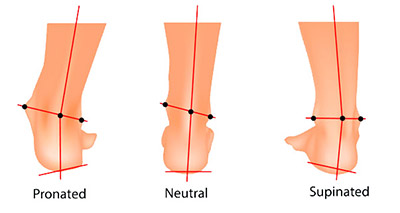Pronation Vs Overpronation Vs Supination
In case you don’t know, pronation is the natural motion of your foot when you are running or simply walking. However, you can have a neutral pronation, overpronation or supination. So, what is the difference between them?
Neutral Or Normal Pronation:

As we already mentioned, pronation is the natural movement of your foot when you run or walk. In this case, your foot usually rolls a bit inward with each step.
Find the best cross trainers for you.
Here is the process when you have neutral or normal pronation:
– As soon as your heel touches the floor, your archs star to flatten and cushion the shock.
– Your weight first goes to the outside of your foot and then back to the big toe.
– Your arch stiffens and rises to ensure that you have the stability that you need as your foot rolls upward and outward.
– While all toes work, the big toe and the second toe are the ones that do more while the others stabilize.
Overpronation:

In case you suffer from overpronation, your ankle rolls too far inward and downward with each step. And the truth is that your ankle will continue to roll when your toes are starting to push off. As you can imagine, only the big toe and the second toe work and your foot just twist more with each step.
These are the best cross trainers for overpronation.
One of the things that you need to know about overpronation is that even though it is common for it to be seen in people with flat feet, this doesn’t mean that everyone with flat feet has overpronation.
One of the main problems of overpronation is that your foot suffers from an excessive rotation which increases the risk of heel pain and injury.
In case you suffer from overpronation, you can wear orthotics, insoles, and motion control shoes that should help you correct your foot motion.
Supination:

You can think about supination as the opposite movement of the overpronation. The truth is that in this case, the rolling motion is made to the outside edge of your foot during a step. In this condition, the weight never gets to your big toe. So, you can easily understand that all the work is made not only by your smaller toes but also by the outer edge of your foot. This ends up putting a lot of stress on your foot.
Supination tends to be more common among people who have high and rigid arches and that just don’t flatten enough during a stride.
Discover the best cross trainers for supination.
In case you just don’t know if you have neutral or normal pronation, overpronation or supination, there are some things that can help you figure out:
#1: Your Shoe Wear Pattern:
Just grab the shoes that you are currently wearing for walking or running and look at their soles. In case you have overpronation, you will see that the shoe should be more worn-out on the inner side of the heel and forefoot. On the other hand, in case you have supination, you should be able to see that the sole is more wear on the outside edge of the shoe.
#2: Shoe Tilt:
Just grab the shoes that you have been wearing regularly in the last couple of months. Just place them on the table and ensure that the heels are facing you. In case you notice that the heels are tilting inward because they are more wear on the inner side of the heel, you may be an overpronator. On the other hand, if the heels are tilting outward, then you may be a supinator.
